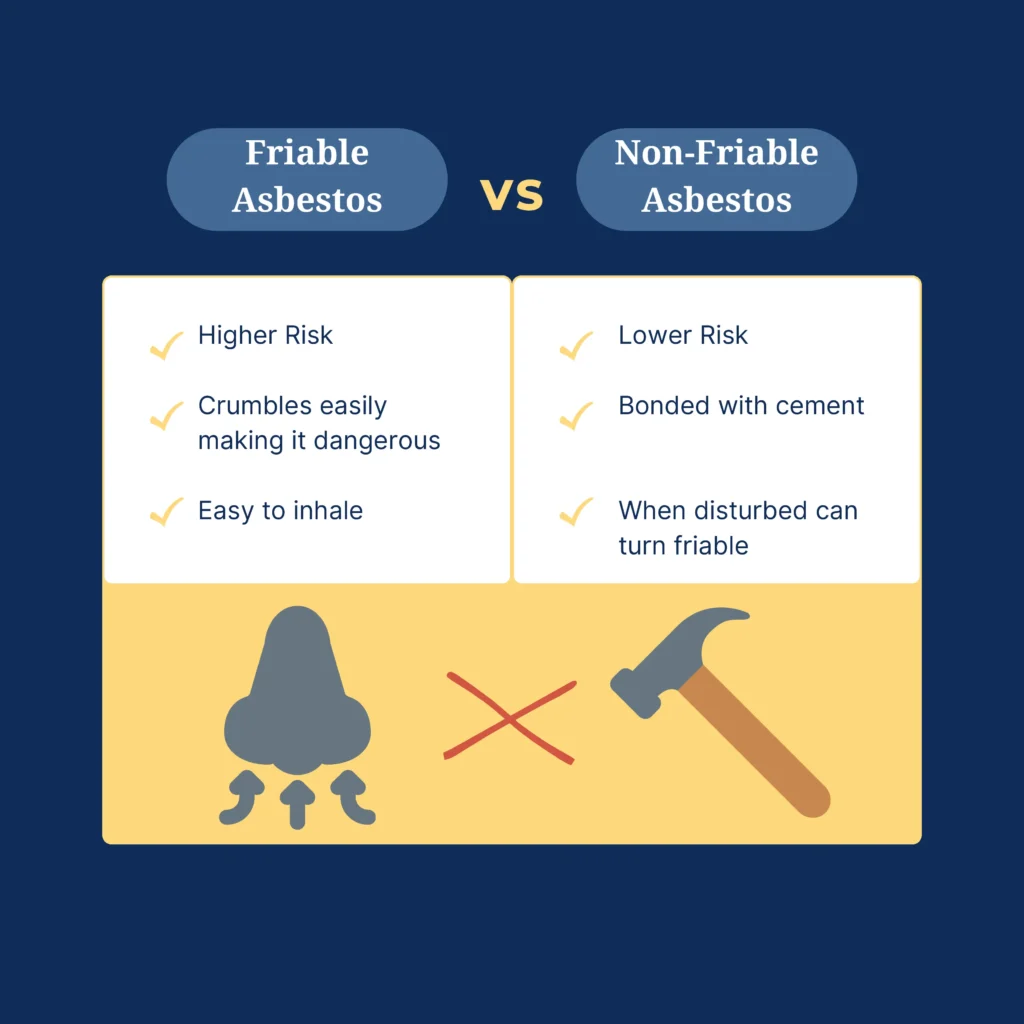The valuable and infamous mineral, asbestos, was discovered in the 1900s to negatively affect human health. Doctors and asbestos workers alike began to notice a disturbing trend. Individuals who were regularly exposed to asbestos, or in this case occupational exposure, were developing horrible respiratory issues. The symptoms ultimately led to the discovery of asbestos-related diseases such as asbestosis and mesothelioma. In response to this, asbestos mines began to close but this did not stop the cases from popping up in the United States. Additionally, the use of these minerals is currently being banned after decades of these adverse health effects. For these regulations to continue, it is important to first establish what asbestos is and the difference between friable and non-friable asbestos.

Asbestos
Asbestos is a family of fibers that includes six types which are “tremolite asbestos, actinolite asbestos, anthophyllite asbestos, chrysotile asbestos, amosite asbestos, and crocidolite asbestos” (“Types of Asbestos – Chrysotile Asbestos, Tremolite Asbestos”). Out of these types, chrysotile is the most commonly used in products and insulation. Due to its heat-resistant properties, it made its presence in buildings, shipyards, and automobiles (“Types of Asbestos – Chrysotile Asbestos, Tremolite Asbestos”).
Friable Asbestos
This type of asbestos is recognized to pose a higher risk compared to non-friable asbestos. Friable asbestos contains qualities that are “generally quite loose and, when dry, can be crumbled into fine material or dust with light pressure” (“Types of Asbestos-Containing Material”). These are additionally reported to be more dangerous because they contain higher levels of asbestos. Some of the products that register as friable asbestos include insulation or loose-fill asbestos as described by the NSW Government.
Non-friable Asbestos
This type of asbestos is recognized to pose a lower risk compared to friable asbestos. They are additionally recognized as “bonded” asbestos given its use. The difference between the two lies in the presentation of the asbestos. In this type, the asbestos is “mixed with cement or other bonding materials” (“Asbestos and Health Risks – Fact Sheets”). While it is not dangerous when presented in materials like building siding or roofing, it can quickly transition into being friable. This can occur when the asbestos-related product is damaged by the weather or by being cut, drilled, water blasted or similar” (“Asbestos and Health Risks – Fact Sheets”).
Removing Asbestos
The Occupational Safety and Health Administration reports there is no “safe” level of asbestos exposure for any type of asbestos fiber” (“Asbestos – Overview | Occupational Safety and Health Administration”). Therefore, it is extremely important to take precautionary measures when removing the mineral from your home if present. Houses that were built between “1930 and 1950 may have asbestos as insulation” (“Asbestos in the Home”). In addition to this, Penn Medicine claims that this estimates “approximately 30 million homes and buildings in the U.S. with some form of asbestos-containing material”. The precautionary measures include wearing gloves, eliminating the use of sweeping or abrasive strippers, and if major pieces need to be removed then it is recommended to consult with a professional asbestos remover.
Health Effects
As previously mentioned, there is no safe amount of asbestos inhalation. This leads to an “estimated 255,000 deaths” globally each year (Furuya et al.). In America alone, this constitutes roughly “12,000 to 15,000” individuals each year according to Asbestos Nation. The diagnoses that arise from asbestos exposure include mesothelioma, asbestosis, and lung cancer. Mesothelioma is a rare type of cancer that can occur in vital organs like the lungs, abdomen, heart, and more rarely the testicles. It originates in the mesothelial tissue and can closely expand to nearer organs or distant ones. There are roughly 3000 mesothelioma diagnoses each year in the United States (“Key Statistics About Malignant Mesothelioma”). This is different from asbestosis which involves a scarring of the “organs or triggering the growth of excess tissue, a condition known as fibrosis” (Nation). This diagnosis presents roughly “1,451” cases each year in the United States (Nation).
If you or someone you know has been affected by asbestos exposure or mesothelioma in the state of Pennsylvania, please fill out this form for a free consultation or call 1 (800) 505-6000 for legal help.
Sources:
https://www.asbestos.nsw.gov.au/identify-asbestos/what-is-asbestos/friable-and-non-friable-asbestos
https://www.health.nsw.gov.au/environment/factsheets/Pages/asbestos-and-health-risks.aspx
https://www.asbestos.vic.gov.au/about-asbestos/types-of-asbestos
https://mesorfa.org/exposure/asbestos-types.php
https://www.ncbi.nlm.nih.gov/pmc/articles/PMC5982039/
https://www.cancer.org/cancer/types/malignant-mesothelioma/about/key-statistics.html
https://www.cancer.org/cancer/types/malignant-mesothelioma/about/key-statistics.html